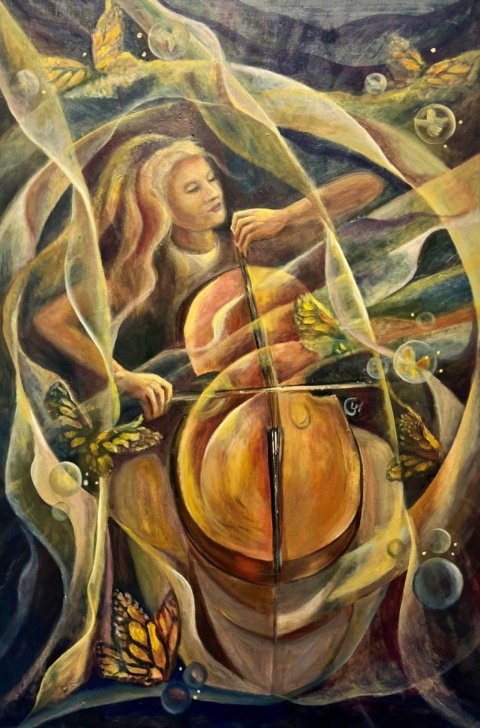
Photo courtesy of the artist
2024 Carlos Malamud Prize winner Tenee’ Hart, (American, b. 1988): “Powdered and Pale,” 2017-2023
Powder, faux pearls, loofa, melted bowls, powder puff, plastic tablecloths, cut-glass lamps, aerolux bulbs, lampshades, metal, mirror, paint and various fibers; 72 x 48 x 30 inches
You read that right: The same exhibit is at two places through the summer. Commanding more local gallery real estate than any other art show at the moment, Pathways exhibits the work of six emerging artists competing for the Carlos Malamud Prize. All of them have work at both Rollins and UCF, with nearly five dozen individual works on display.
We managed a few minutes with Malamud at the May 31 opening, where his eyes twinkled with excitement over the impending announcement of the winner. “So many young artists have great talent, but are shy about promotion,” Malamud observed. “We wanted a barrier-free process to give talent a chance to get started.”
Having started the Miami Prize in the Miami-Dade high schools, Malamud decided to embark on a collaborative UCF-Rollins biannual cycle of juries and exhibits. Together with curators Gisela Carbonell of Rollins, Shannon Lindsey of UCF, independent curator Ginger Gregg Duggan of CuratorSquared and collector Dennis Scholl, the 2024 jury also included the previous winner, Eugene Ofori Agyei.
The 2024 Carlos Malamud Prize winner, Tenee’ Hart, will receive $10,000, as well as guidance and mentorship from the jurors. She will have a UCF Art Gallery solo exhibit in 2025 and be a member of next year’s jury.
Prize-giving can also be taste-making and trend-setting. The finalists this year were photographers, sculptors and installation artists. Hart’s installations of fiber sculpture, which she describes as “wrapped, knotted, sewn and housepaint-slathered,” occupied corners and alcoves, softly lit with pink and lavender lighting, their organic qualities evoking domestic femininity on the surface but with a manic creepiness underneath.
2024’s finalists are outstanding. Samuel Aye-Gboyin, a Florida photographer originally from Ghana, brings an unusually mature eye to portraiture, elevating Ghanaians in their everyday lives with gorgeously lit, seemingly casual black and white compositions. Fernando Ramos photographs in color, and takes his portraiture a step further with many subjects in masks or costumes. Diego Alejandro Waisman, originally from Argentina, pursues themes of displacement in his photographs of Miami’s trailer parks, which have their own dark poetry about them. Clio Yang is a Florida-based mixed media artist; besides photography, Yang’s video installation “Blind Box” at UCF is seen through a scrim jumping with text and drawings. Her video work is a compelling look at global digital culture and references feelings of disconnection and searching.

Photo courtesy of the artist
Patricia L. Cooke (American, b. 1988): “Hollow,” 2023
Neoprene, polyester boning, thread, ribbon, dimensions variable.
In both galleries, Patricia Cooke’s furniture installations and wall sculptures occupy vertical and horizontal space. Pink neoprene is scissored and sewn into elaborate Victorian rocking chairs, dressers, end tables, and they’re all suspended by wide pink cloth tape from the ceiling above. Cooke’s stated inspiration was to re-create the feeling of her grandmother’s living room, but the effect is like this stuff just shot down from somewhere, leaving contrails perhaps tied to a ship somewhere far above. We asked her why neoprene, and she confided there was a surplus after the pandemic (neoprene makes good masks). It gave the mock furniture a kind of unbearable sweetness.
Sweet or tart, this show’s a great tour of Florida’s up-and-coming visual art talent. Each gallery has unique ways of presenting the work, and if you are able to see both you can start to see what Malamud sees in these artists: consistency, rigor and talent. Art, as a pursuit, usually has humble beginnings, and getting a push in the right direction can often make the difference in an artist’s career. The two galleries exhibiting Pathways give viewers a chance to be in on the talent-spotting game for Florida’s future art stars.
Why Pathways is suddenly rising in the Central Florida arts scene has a lot to do with behind-the-scenes story of the two institutions involved. Orlando Weekly learned a lot talking with the curators and Malamud himself about why the real estate grab is an encouraging story for artists.
Both RMA curator Gisela Carbonell, and UCF Gallery director Shannon Lindsey state that the aim of Pathways is to build a network between accredited institutions and emerging artists. They want to create an opportunity emerging artists rarely get — namely, to show in a museum setting. As the name implies, Pathways is not a one-and-done show, but rather a sustained mentorship with art world professionals. It is the only art prize coordinated by two academic institutions that offers this depth of access to artists.
All things that arise eventually converge, and this idea arose at the same time Carlos Malamud was completing a Miami Prize cycle with high-school art students. Malamud sought ways to amp it up and began talking with Rollins Museum of Art director Ena Heller, who immediately connected everyone up and the Malamud Prize quickly coalesced.
Underwriting the efforts is the Pabst Steinmetz Foundation, a local philanthropy helping community projects in the arts and education world. The uniqueness of the Malamud Prize, with its focus on emerging artists and ongoing career support, made the Malamud Prize an obvious choice for a grant. Thus the 2022 prize was born, with this year’s scope even larger.
Humble circumstances mark the start of many visual artists’ careers. With Pathways, Central Florida will be home to a startling new project that may finally help, along with other universities, put to rest the old lone-wolf, starving-artist trope and mentor artists into the networked, financially savvy and fast-moving 21st century.
Additional reporting by Kyle Eagle.
Subscribe to Orlando Weekly newsletters.
Follow us: Apple News | Google News | NewsBreak | Reddit | Instagram | Facebook | Twitter | or sign up for our RSS Feed

